|
1704
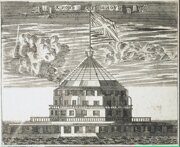
The first fort Kronshlot (Crown Castle) was constructed. It was ceremonially consecrated in Peter the Great presence on the 7th of May 1704 (Old Style calendar). Kronshlot worthily stood up to the Swedish squadron in July 1704 and in June - July 1705. From 1717 to 1724 close to the fort a harbor was built that formed Kronshlot into a five-cornered construction with 120 weapons.
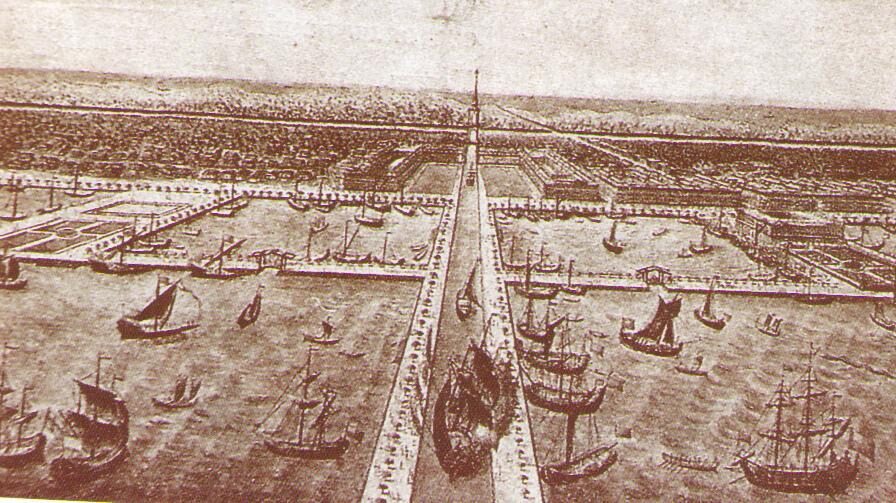 |
1719
According to the Peter the Great decree the building of the dry dock began to repair underwater part of ships and vessels. By 1752 this grandiose for that time hydraulic engineering construction had been finished. From this dock water flew down to the pool just in 24 hours. Originally water was pumped from the pool by wind pumps, from the end of the XVIII century - by a steam-engine. The new dock was an implementation of ambitious innovative invention which showed that Russia was ahead of the European countries in this issue.
|
|
1720

The construction of the Italian palace of A.Menshikov by the architect I.Braunshteyn's design begins. Italian masters took part in decoration works of the building. Naval Cadet School was located here from 1771 and later - Navigator and Engineer schools.
|

1722
The building of the fort "Citadel" began which was finished in 1724. Its reconstruction in stone started in 1824. Nicolay I renamed this fort into "Emperor Peter the Great" in 1834. The fort was completely armed by 1835 (74 canons).
|
|

1729
Peter II officially approved the arm of Kronshtadt. Catherine II approved the arms of Kronstadt in its present appearance on the 7th of May 1780. |
 |
1783
According to the Catherine II decree the construction of the following facilities started in Kronshtadt: Obvodny cannel, warehouses (shops) on its inner side, rope factory, sugar plant, workshops at Petrovsky dock. Dock Admiralty was founded by 1798.
|
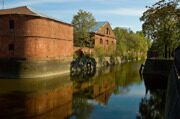 |
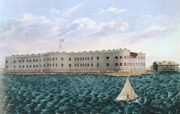 |
1799
Steam engine from Scotland was installed to pump water from the pool of Petrovsky dock. It was one of the biggest engines in Europe. The second steam engine was built in 1791-1792 in Kronshtadt.
|
 |
 |
1803
The first round-the-world expedition of "Hope" and "Neva" sloops took place. Captain-lieutenant I. Kruzenshtern was the head of the expedition, he was also in command of sloop "Hope". The commander of "Neva" was captain-lieutenant U. Lisyansky. This first campaign was the beginning of the numerous long distance voyages of Russian sailors. From 1803 till 1855 years 41 sailongs were made.
|
 |
|
1804
The first water pipe in Russia was constructed.
The stone Dutch kitchen was built instead of the previous wooden one constructed in 1720. Foreign and Russian cooks prepared meal here for their crew sailors as it was forbidden to light a fire on sailing vessels in a harbor.
|
 |
 |
1815
The first in Russia steamship line St.Petersburg - Kronshtadt was opened. In 1817 during the navigation period twice a day regular voyages started.
|
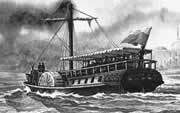 |
 |
1817
The temple in the name of St. Andrew the First Called Apostle was built by the architect A.D.Zaharov design and consecrated. The cathedral is well-known for the fact that St. John of Kronshtadt served here for 53 years.
|
|
1819
The first Antarctic expedition of Russian sailors on "Vostok" and "Mirnyj" sloops under the command of F. Bellingsgauzen and M. Lazarev took place. This expedition discovered a new continent Antarctica on the 16th of January, 1820.
|
 |
 |
1824
A complex of custom buildings was built by the architect I. Lukini design on the western bank of the Italian pond.
The town was destroyed by one of the strongest and destructive flooding.
|
 |
1832
The constructing of the Sea Arsenal began. The arsenal had unique collections of domestic and trophy canons, shells, guns and flags.
|
|
1833
The constructing of Gostiny Dvor by V.Maslov design started.
|
 |
 |
1834
For the first time in Russia a trial of rocket submarine by the engineer K. Shilder was conducted.
|
1836
The construction of the fort "Emperor Alexander I" started and was finished in 1845 by the engineer-gen.-lieutenant M.Destrem design. On this fort the laboratory for experimental medicine on manufacturing of medical products against bubonic plagues was consecrated in 1899. There were just two such laboratories in the World - in France (near Paris) and in India (Bombay). The laboratory was very good equipped: independent electric power station, boiler-house, the first in Russia lift for lifting experimental animals. All the waste was under disinfection in autoclaves. Various scientists-microbiologists lived and worked here - real devotees of their noble work.
|
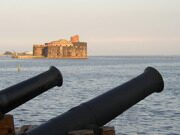 |
 |
1839
For the first time in Russia the leading surgeon - the professor of the Kronstadt Sea Hospital V. Karavaev - made a successful heart operation under the direction of the chief doctor A.Kiber.
|
|
1840
Naval officer-hydrographer M.Rejneke placed a depth-gauge-ruler and arranged regular measuring of the zero - point of the water level on one on Sinij bridge - Kronshtadt water gauge rod. Measuring of the water level in Kronshtadt have been regularly made since 1777 and were begun in 1707 but not regularly. Absolute altitude of Earth surface, sea depth on navigation and topographic maps, space altitude are measured according to the Kronshtadt "null" level of water gauge rod.
|
 |
|
1847
The steam vessel building factory was under construction. However due to the Crimean war the factory opening was delayed and the top management of fleet made a decision to finish the building of this factory not as a ship-building but as a ship-repair and ship-mechanical factory.
|
|
1854
During the Crimean war incorporate English-French squadron (80 ships) began a siege of the Kronshtadt fortress and after unsuccessful attempts to storm Kronshtadt they came back home. Some mine fields by the special system of Russian academician B.Jakobi were on the enemy way in front of forts. It was a novelty and only Russians had it. English and French sailors called these shells 'infernal machines" and "floating death".
|
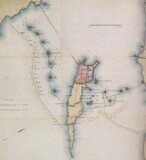 |
1855
The building of 1, 2, 3 southern forts and 1, 2, 3, 5, 7 northern forts was under the direction of engineer-general E. Totleben. The building of these forts was finished in spring 1856.
|
1857
For the first time in Russia the Naval Astronomical laboratory was founded.
|
1864
The first in the world ice-breaker "Pilot" was built on the private factory of engineer-businessman M.Britnev. This vessel conducted a raid between Kronshtadt and Oranienbaum. In 1868 the first in Russia diving school was founded by Britnev in Kronshtadt.
|
 |
 |
1866
The trial of the biggest submarine of that time was held. This submarine of 360 tons displacement had a mechanical engine by the Kronshtadt port employee I. Aleksandrovsky design. The boat crew consisted of 20 persons.
Later by I. Aleksandrovsky design the first self-propelled torpedo was produced. But, unfortunately, it was not added to Russian Navy fleet arsenal as in Italy at Whitehead factory in Fiume city such torpedoes were cheaper.
|
1872
Everyday dry shot from midday weapon at 12.00 was initiated.
|
1874
The Vladimir Icon of the Blessed Virgin Cathedral was built according to the architect H.Greyfan design. Nowadays inside the cathedral praying services are conducted.
|
 |
1879
The first in Russia telephone communication was established. The new building of a secondary educational institution by the architect V.Vindelbandt design was ceremonially consecrated on the 28th of August 1879.
 |
1896
A. Popov invented the first in the world radio set, X-ray apparatus for Sea Hospital by which the first in Russia roentgenogram was made.
|
|
1905
Revolutionary sailors participated in disturbances of 1905 - 1907.
|
|
1910
For the first time in the World the experience of Professor S. Dzzhergovsky was used - water chlorination (during Soviet period -water Ionization).
|

1913
The constructing of the main Russian Naval Cathedral in the name of Saint
Nicholas the Wonderworker by the architect V.Kosjakov design was finished.
|
|
1914
It is a year of the constructing of "Red hill", "Grey Horse", "Ino". The fort "Reef" was put into service. "General Obruchev" and "General Totleben" forts (the construction started in 1898) were implemented.
|
|
1917
Temporary government came to power. Bolshevik party became the strongest one. The October revolution occurred. Kronshtadt citizens played a very important role in the country's history and in a destruction of tsarist Russia.
|
|
1921
The Kronshtadt garrison and commands of several Baltic fleet ships used weapons against "military communism" - a well-known Kronstadt revolt that was rigidly repressed by the Bolsheviks.
|

1941
German aircrafts began a waterway mining at 3a.m. on the 22nd of June.
The biggest raid of Luftwaffe on Kronshtadt occurred on the 23rd of September. This event was called a Kronshtadt battle. More than 300 bombs were thrown down on the town.
|
|
1943
Medal "For Leningrad defense" was handed out to foremost Kronshtadt citizens - Leningrad defenders. In 1944 Sea Plant was rewarded with the Order of Lenin, working people of the town were rewarded with orders and medals for service in battle during the Great Patriotic War. Kronshtadt Sea Hospital was also rewarded with the Order of Lenin in 1942.
|
|
1984
As a result of the flood protection barrier constructing Kotlin Island from its Northern side was jointed with a continent by a highway.
|
|
1999
The active reconstruction of The Vladimir Icon of the Blessed Virgin Cathedral was begun.

2011
The end of the construction of Saint-Petersburg Flood Protection Barrier and the openning of the underwater tunnel - the road to the southern part of the land.
 2013 2013
The opening of the Naval Cathedral was conducted after its completed restoration to its 100th anniversary from the consecration day.
|
|














































 2013
2013